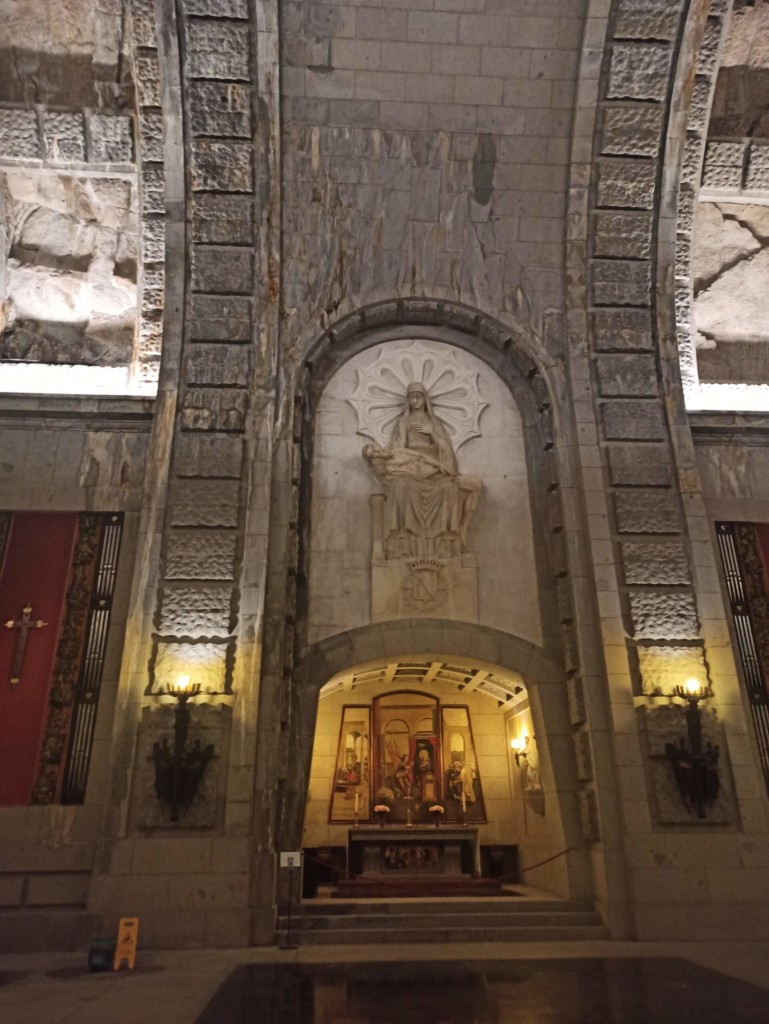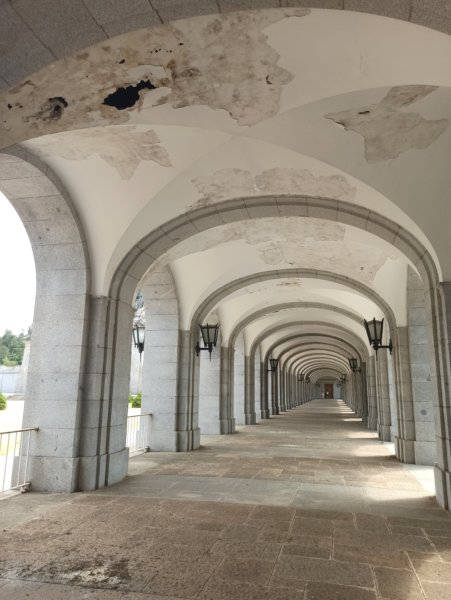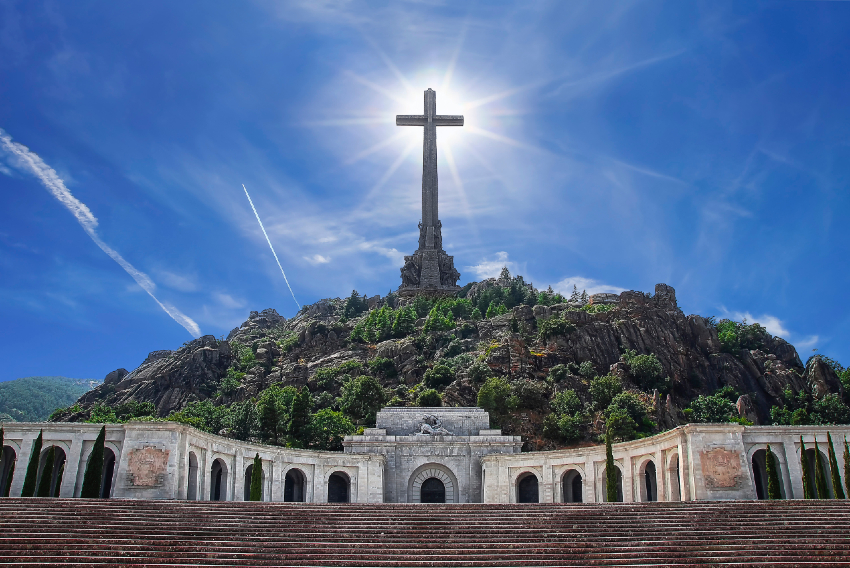Letter #101, 2022, Thurs, Aug 18: Spain
There is a proposal in Spain to pass a law this fall that would close a Catholic Benedictine monastery and remove the largest cross in the country — and perhaps the world — which is located on the monastery property (see picture and story below — the article was published by the One Peter Five website as part of its series on Hispanic Catholicism).
***
There is a continuing cultural battle in Europe between the nearly 2,000-year-old Christian, and Roman Catholic, beliefs and traditions of many European countries, and the more recent effort since the time of the French Revolution in the 1790s to leave that Christian tradition behind as something not valuable, even something to be ashamed about and condemned.
There is no doubt that very painful struggles between Christian and what we may call “secular humanist” tradition have occurred in these past two centuries, as was the case on the Spanish Civil War in the 1930s.
But, it has been the deeply held believe of many great saints, scholars and writers that faith in Christ has been a great blessing for Europe, creating the cultural context for many of Europe’s most distinctive social and cultural achievements — a continental system of hospitals, of schools, of universities, and a general commitment to the concept of the dignity of the human person, and the dignity and sacrality of the family.
The effort to eliminate leading monuments of this Christian tradition is therefore a matter of deep concern not only for Catholics, and all Christians, but also for very many who do not share the faith of the Church but who are of good will.
It would seem important to develop alliances with such people of good will to preserve the monuments of Christian faith which have contributed so much to our Western culture.
Below, an article about a basilica and a large cross in Spain which have become the subject of controversy. —RM
Leftists Target Spain’s Relics and World Record, Public Cross (link)
August 18, 2022
Spain’s government could finish passing a law this autumn to turn the Basilica of the Holy Cross of the Valley of the Fallen – the world’s longest basilica – into a “museum of the horrors of Franco” and to destroy its cross – the world’s largest – due to its association with General Francisco Franco.
The new law also aims at kicking the Benedictine monks, its custodians since 1958, out of the Basilica’s adjacent abbey and at exhuming the bodies of the thousands of martyrs and victims of both sides of the Spanish Civil War buried there.
The Catholic Church has already recognized 66 of them as martyrs and three more will be recognized in November. There are also over 40 Servants of God whose beatification process is underway.
This means the walls of the Basilica’s side chapels of the barrel vault leading up to the main altar hold relics of numerous saints.

One of the side chapels leading up to the main altar. The corpses of the Civil War victims lie behind these side chapel walls. Photo by the author, Estefanía Aguirre.
During an interview with the prior administrator of the Valley’s Benedictine community, Father Santiago Cantera, he affirmed “the problem is people’s great indifference and ignorance, but I think there are more people who are opposed to destroying this place than people who favor that.”
“Many people are fed up with (the government) stirring up issues about the [Spanish Civil] war because what we really have in Spain are economic, social and employment concerns,” he added on August 3.
According to the prior, a former university professor with a PhD in medieval history and author of 21 books, society needs to “become aware of (the Valley’s) artistic, cultural and religious value, which is supra-political.”
“We cannot continue to use the War of almost a century ago to argue in favor of political groups that do not have a project for the future and want to use the past to back up a Constitution for a new Republic,” he underscored.
The ‘Democratic Memory Law’ was approved in July by the Congress of Deputies and will be debated by the Senate this September. Anglo readers will recognize these textbook Marxist tactics of the “memory hole” from George Orwell’s 1984.
The new law will enable the exhumation of the nearly 34,000 fallen from both sides of the Spanish Civil War (although other estimates believe the real numbers are 50,000-70,000). This means the destruction of half of the basilica.
The Asociación para la Defensa del Valle de los Caídos (Association for the Defense of the Valley of the Fallen), composed of 212 families of people buried there from both sides, are firmly opposed.
Its president and fierce defender of the Valley, Pablo Linares, is from the family of a Communist who worked at the Valley under Franco after the War. The father, sister and uncle of the monastery’s abbot emeritus, Father Anselmo Álvarez Navarrete, are also buried there.
The law will mandate the creation of a ‘National Bank of DNA of victims of the Civil War,’ the eradication of foundations that “exalt” Franco’s regime (including the Foundation of the Holy Cross of the Valley of the Fallen), and will prohibit teachers from speaking positively about Franco – an attack on academic freedom. It will also demand changing the name from Valle de los Caídos (Valley of the Fallen) to Cuelgamuros.
Although it is not specifically outlined in the law, there have been numerous talks of also destroying the basilica’s cross, accusing it of being a symbol of “national Catholicism.”
About the Valley of the Fallen
The basilica is an underground church carved inside a mountain, within a precinct that covers 3,360 acres of woodland. The site also contains a Benedictine abbey and guesthouse, adjacent to the basilica.
Franco ordered the basilica and abbey’s construction in order to reconcile the wounds of the Civil War. The monks offer daily Masses at the basilica for the souls buried there and for Spain’s unity, accompanied by the angelic Gregorian chants of a boarding choir school for boys which they run. (…)
The Escolanía is the only place in the world that teaches children how to read Gregorian chant in its oldest forms, Gregorian paleography. They learn to sing by reading the tetragram and two even older pneumatic scripts. It currently has about 50 students, aged between eight and eighteen.
According to historian Alberto Bárcena Pérez, Franco wanted to bury as many victims as possible within the Basilica and obtained the help of town halls as well as written authorization from the victims’ families.
Franco was buried there behind the altar, although he had never requested it. The government exhumed his body, despite opposition from Franco’s family and the monks, on 24 October 2019. Bárcena claims the exhumation was part of a Masonic Scottish rite due to the way the authorities positioned themselves at the event. The monks privately celebrated numerous Masses and acts of reparation afterwards.
After the law is passed, the government wants to exhume the body of José Antonio Primo de Rivera, founder of the Falange, who is buried in front of the altar. He was shot to death by the Republicanos aged 33. Both Franco and Primo de Rivera died on Nov. 20, though decades apart.
Earlier this year, the Guinness World Records recognized the Basilica’s cross as the world’s “largest free-standing cross” measuring 152.4 meters (500 ft) tall and its Basilica as the longest in the world with 260 meters (853 ft) in length.[1]
The basilica is located 45 kilometers (28 miles) west of Madrid and took 21 years to build (1937-1958) at a cost of about €211 million euros. It was elevated “to the honor and dignity of a minor basilica” in April 1960, under Pope John XXIII.
Due to the area’s great geological stability and isolation, it also has an underground laboratory of gravimetry and tides in two of its basements. Researchers from around the world use it to study earth tides, gravimetry and absolute gravity.
The whole precinct operates through the Fundación de la Santa Cruz del Valle de los Caídos (Foundation of the Holy Cross of the Valley of the Fallen).
The Foundation is owned by both the Government of Spain, managed previously by the Head of State but now by the government’s Patrimonio Nacional (National Patrimony), and the Benedictine monks. Patrimonio is in charge of managing funds and of the maintenance works of the buildings, which it does mainly by selling entrance tickets at the main entrance gate at the bottom of the Valley. The law states that it has to give part of this money to the monks so they can maintain the employees of the Escolanía and of the guesthouse.
But Patrimonio stopped paying the monks four years ago in an attempt to strangle them economically. The monks are now maintaining the precinct themselves with private donations and other funds, but Patrimonio blocks any maintenance works even through private donations. Patrimonio was paying them €340,000 euros annually for all their expenses. So the government currently owes them €1,360,000 euros.
As a result of the lack of funds and the obstacles placed by Patrimonio, the upkeep of the grounds and monuments have been neglected. Architects have estimated the damages of the abbey and Basilica to be in the millions.
[Article continues below photos]

Visible damages under the arcade connecting the abbey to the guesthouse due to the negligence of Spain’s National Patrimony. Photo by the author, Estefanía Aguirre.

Visible damage to the stone right under the dome. The white stains are caused by water dripping from inside the mountain for decades. Photo by the author, Estefanía Aguirre.

Visible damage to the stone in the underground tunnels that connect the abbey to the basilica. The white stains are caused by water dripping from inside the mountain. Photo by the author, Estefanía Aguirre.
Fifteen Years of Ferocious Harassment
Ever since the government of Zapatero passed the ‘Historical Memory Law’ in 2007, the government has made its special mission to make life hell for the monks.
“Ever since the time of Zapatero, we’ve been ferociously harassed,” stated Fr Cantera.
“I had a very hard time four years ago, but I took it as a purification from which I came out strengthened,” revealed Fr Cantera. “It was all because of the media harassment, the attempt to make a public mockery of me in the Senate when they summoned me on the subject of exhumations.”
“Since there were families who opposed the exhumation of the remains of other fallen, as is currently the case, at that time we (the monks) were forced to intervene and present an appeal, and the courts decreed a series of precautionary measures suspending the procedure,” he continued. “From then on, as they had judicially lost the first battle, they began harassing me in the media and denigrating me as a person.”
Despite the struggles, the community has been receiving numerous young vocations. There are six monks under the age of 30: three who have professed temporary vows, two with solemn vows, and one postulant that will soon be joining.
The Benedictines take a vow of stability added to those of poverty, chastity and obedience. When they go to a place, they park themselves there come hell or high water. Many have been martyred for this very reason throughout history.
If the world remains apathetic to the current events surrounding the Valley and the Taliban-like government, Spain may have martyrs once again in the not so distant future.
Note: To help the monks you can donate at: valledeloscaidos.es/colabora, scrolling down to where it says “Continuar” or through a transfer to the following:
Beneficiary: ABADIA SANTA CRUZ
IBAN: ES34 2100 4074 27 1300142701
BIC/SWIFT: CAHMESMMXXX
[1] The Guinness record says that construction began in 1937, but this an error. Everything was planned from 1940 and the works began shortly after.
About the Author: Estefanía Aguirre is an experienced journalist who has lived in several countries and speaks five languages. She holds a Master’s degree in international journalism from Falmouth University.







Facebook Comments